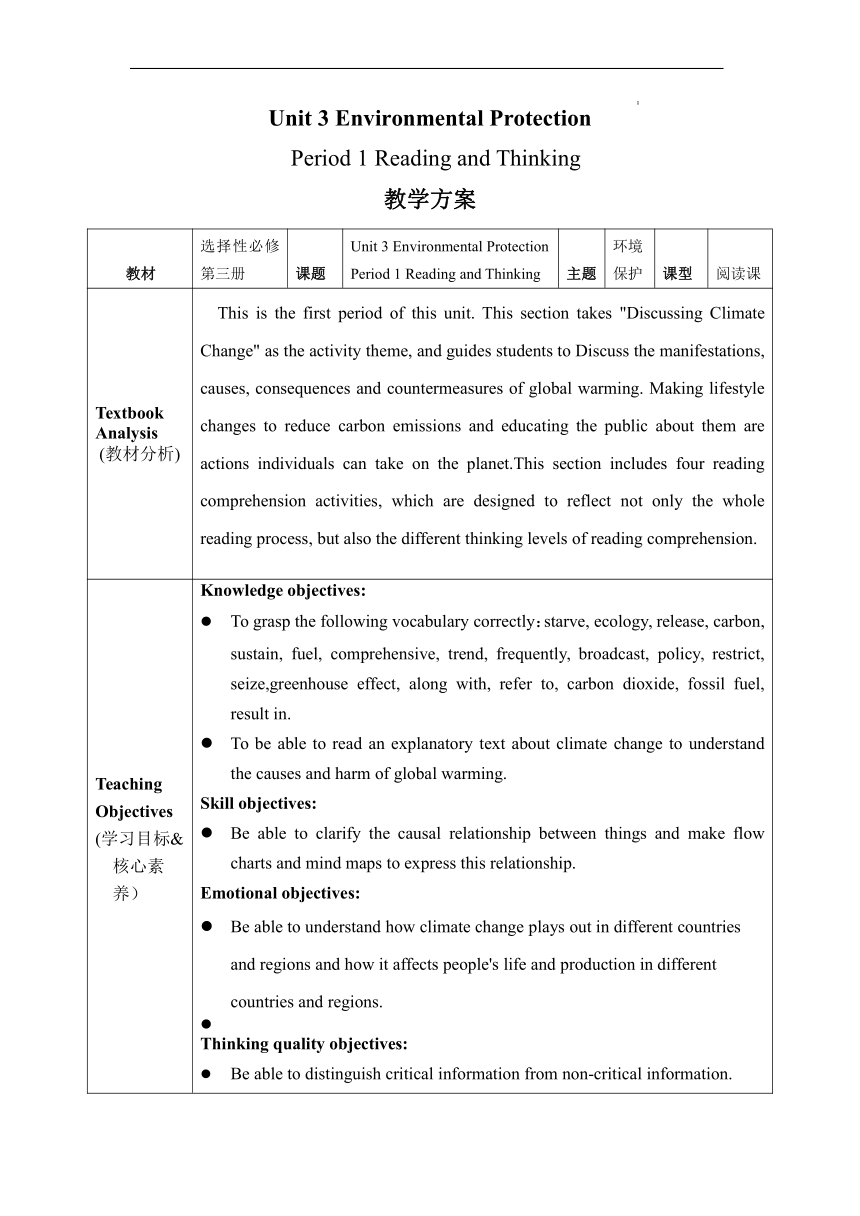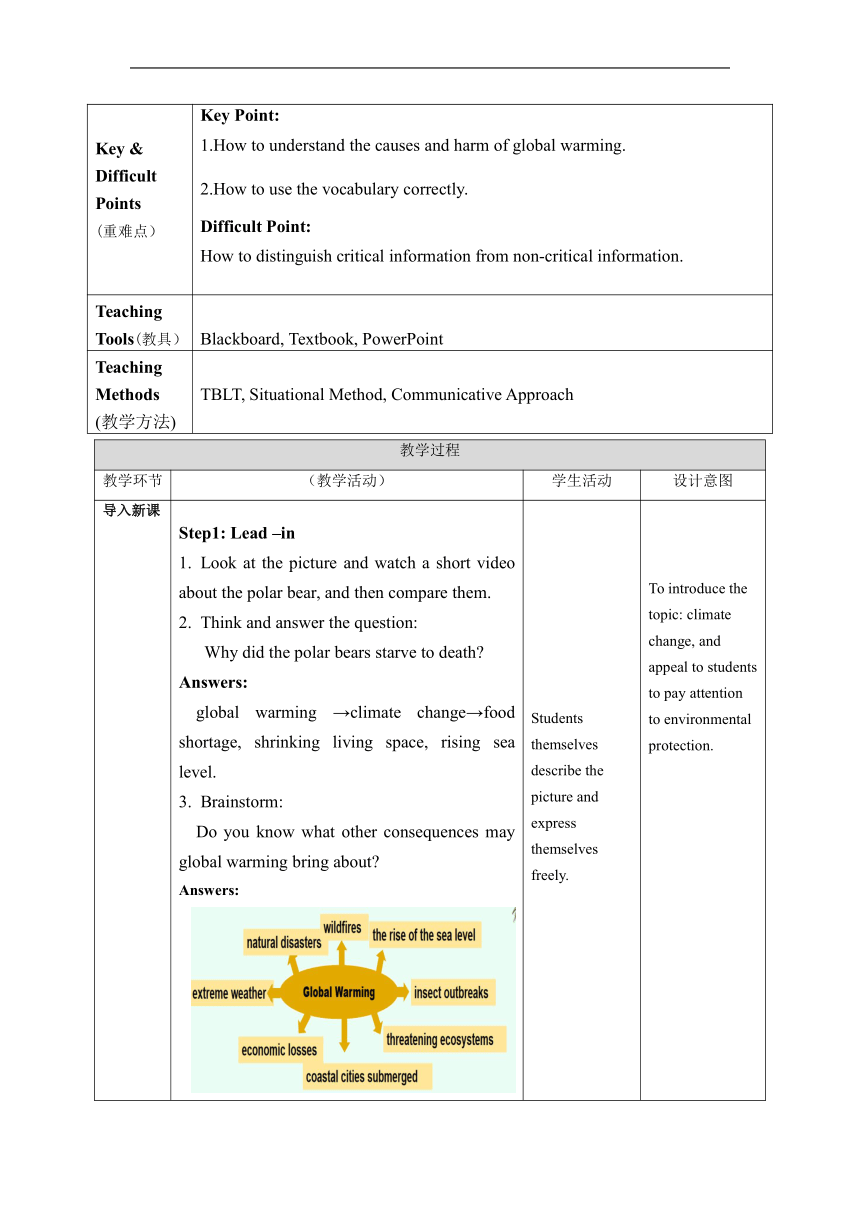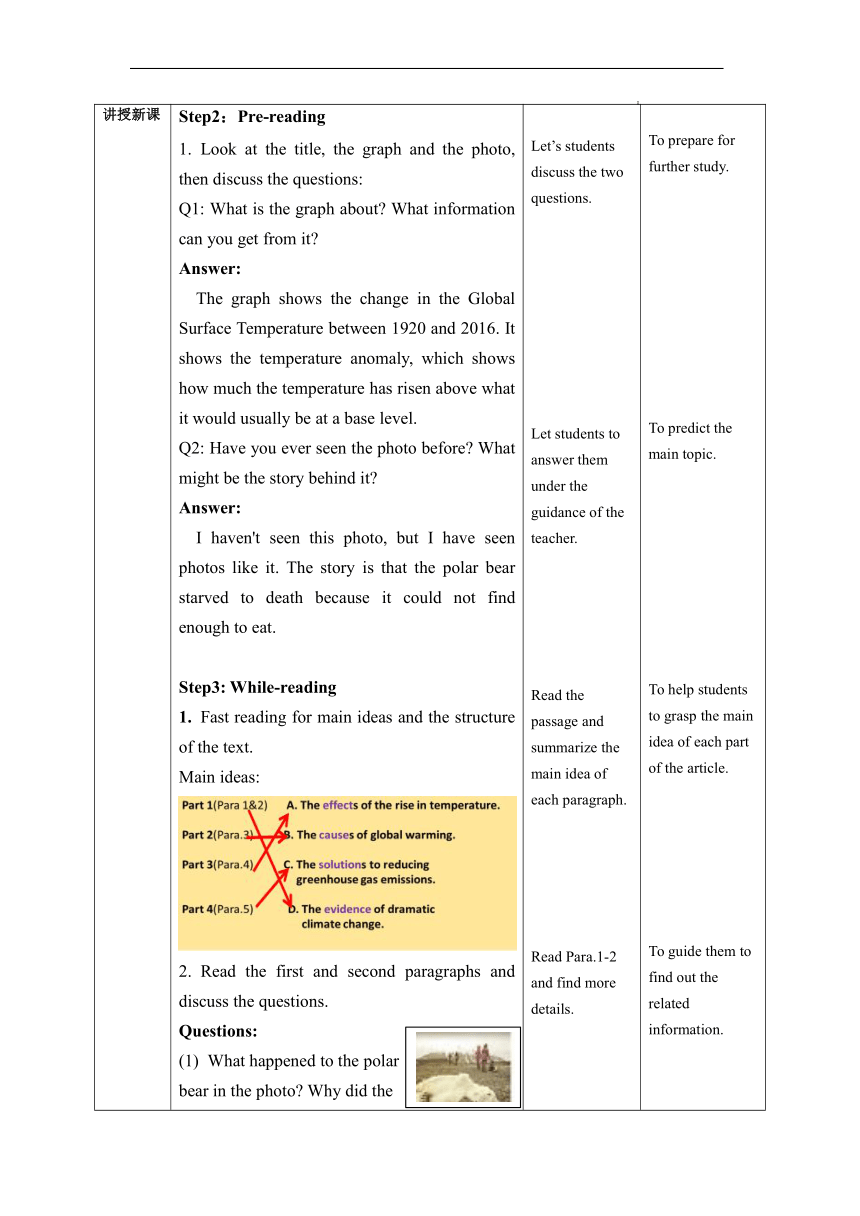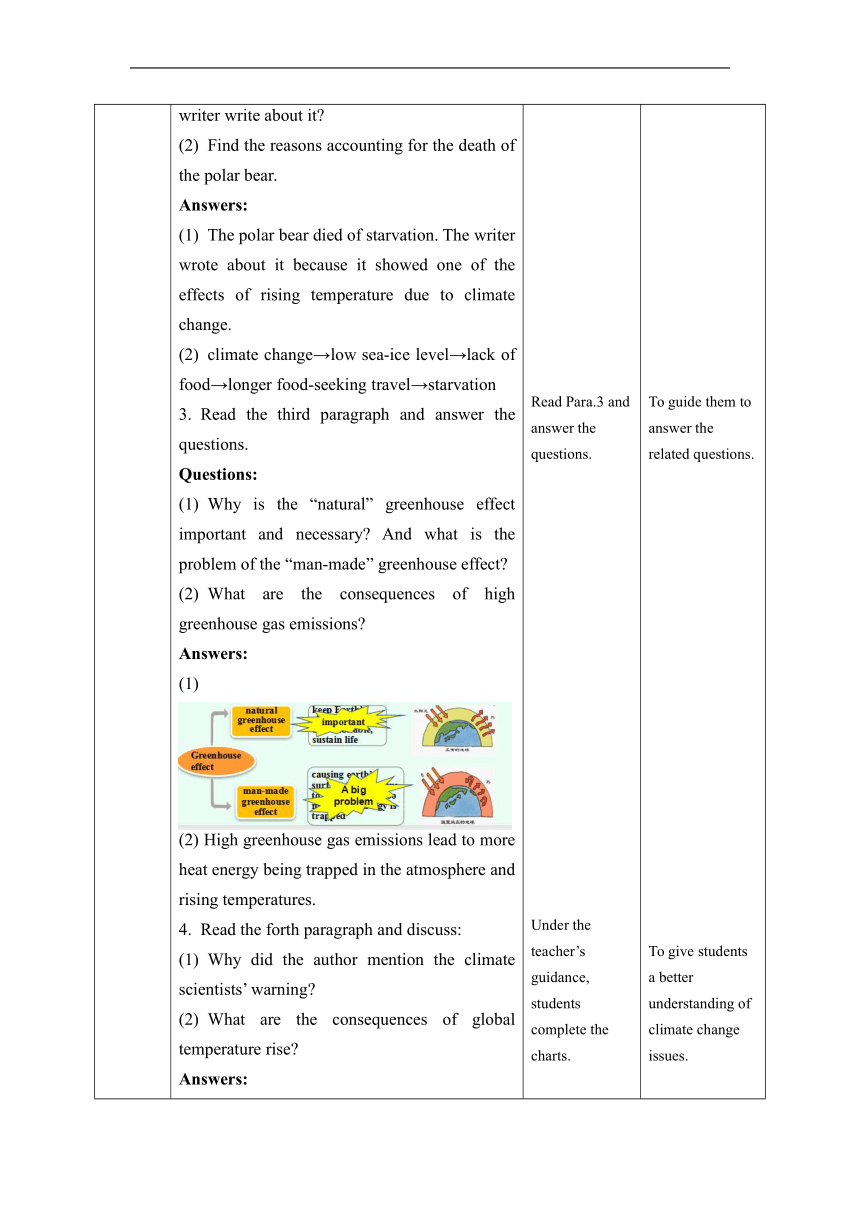人教版(2019)选择性必修第三册Unit 3 Environmental Protection Reading and Thinking 教案 (表格式)
文档属性
| 名称 | 人教版(2019)选择性必修第三册Unit 3 Environmental Protection Reading and Thinking 教案 (表格式) |

|
|
| 格式 | docx | ||
| 文件大小 | 440.0KB | ||
| 资源类型 | 教案 | ||
| 版本资源 | 人教版(2019) | ||
| 科目 | 英语 | ||
| 更新时间 | 2023-10-06 16:19:56 | ||
图片预览




文档简介
Unit 3 Environmental Protection
Period 1 Reading and Thinking
教学方案
教材 选择性必修第三册 课题 Unit 3 Environmental Protection Period 1 Reading and Thinking 主题 环境 保护 课型 阅读课
Textbook Analysis (教材分析) This is the first period of this unit. This section takes "Discussing Climate Change" as the activity theme, and guides students to Discuss the manifestations, causes, consequences and countermeasures of global warming. Making lifestyle changes to reduce carbon emissions and educating the public about them are actions individuals can take on the planet.This section includes four reading comprehension activities, which are designed to reflect not only the whole reading process, but also the different thinking levels of reading comprehension.
Teaching Objectives (学习目标&核心素养) Knowledge objectives: To grasp the following vocabulary correctly:starve, ecology, release, carbon, sustain, fuel, comprehensive, trend, frequently, broadcast, policy, restrict, seize,greenhouse effect, along with, refer to, carbon dioxide, fossil fuel, result in. To be able to read an explanatory text about climate change to understand the causes and harm of global warming. Skill objectives: Be able to clarify the causal relationship between things and make flow charts and mind maps to express this relationship. Emotional objectives: Be able to understand how climate change plays out in different countries and regions and how it affects people's life and production in different countries and regions. Thinking quality objectives: Be able to distinguish critical information from non-critical information.
Key & Difficult Points (重难点) Key Point: 1.How to understand the causes and harm of global warming. 2.How to use the vocabulary correctly. Difficult Point: How to distinguish critical information from non-critical information.
Teaching Tools(教具) Blackboard, Textbook, PowerPoint
Teaching Methods (教学方法) TBLT, Situational Method, Communicative Approach
教学过程
教学环节 (教学活动) 学生活动 设计意图
导入新课 Step1: Lead –in Look at the picture and watch a short video about the polar bear, and then compare them. Think and answer the question: Why did the polar bears starve to death Answers: global warming →climate change→food shortage, shrinking living space, rising sea level. Brainstorm: Do you know what other consequences may global warming bring about Answers: Students themselves describe the picture and express themselves freely. To introduce the topic: climate change, and appeal to students to pay attention to environmental protection.
讲授新课 Step2:Pre-reading Look at the title, the graph and the photo, then discuss the questions: Q1: What is the graph about What information can you get from it Answer: The graph shows the change in the Global Surface Temperature between 1920 and 2016. It shows the temperature anomaly, which shows how much the temperature has risen above what it would usually be at a base level. Q2: Have you ever seen the photo before What might be the story behind it Answer: I haven't seen this photo, but I have seen photos like it. The story is that the polar bear starved to death because it could not find enough to eat. Step3: While-reading Fast reading for main ideas and the structure of the text. Main ideas: Read the first and second paragraphs and discuss the questions. Questions: What happened to the polar bear in the photo Why did the writer write about it Find the reasons accounting for the death of the polar bear. Answers: The polar bear died of starvation. The writer wrote about it because it showed one of the effects of rising temperature due to climate change. climate change→low sea-ice level→lack of food→longer food-seeking travel→starvation Read the third paragraph and answer the questions. Questions: Why is the “natural” greenhouse effect important and necessary And what is the problem of the “man-made” greenhouse effect What are the consequences of high greenhouse gas emissions Answers: (1) (2) High greenhouse gas emissions lead to more heat energy being trapped in the atmosphere and rising temperatures. Read the forth paragraph and discuss: Why did the author mention the climate scientists’ warning What are the consequences of global temperature rise Answers: Because it is essential that we take action and so it needs to be brought to everyone’s attention. Read the fifth paragraph and find the solutions to the global temperature rise. Answer: Create a diagram describing how the greenhouse effect works. Answer: Thinking:what is the author’s purpose of writing this text Suggested answer: The author’s purpose is to arouse our awareness of the problem of the rising temperature and appeal to us to take appropriate actions to deal with climate change. Step4: Post-reading Group discussion: Talk about what you can do to curb global warming Suggested answers: Sort the garbage Abate the use of plastic bags Value our own role End wasting resources Encourage others to participate in it Alter our lifestyle Ride a bike or walk to school Turn off the power when not in use Help promote environmental protection → Save Earth What examples of extreme weather and disasters do you know Answers: Step5: summary Step6: Homework Make a poster about what we can do to balance our needs and sustainable nature. Let’s students discuss the two questions. Let students to answer them under the guidance of the teacher. Read the passage and summarize the main idea of each paragraph. Read Para.1-2 and find more details. Read Para.3 and answer the questions. Under the teacher’s guidance, students complete the charts. Under the teacher’s guidance, students try to complete the diagram. The teacher asks the students to read the passage again and think the question. Ask the students to have group discussions. The teacher guides the students to make a summary. To prepare for further study. To predict the main topic. To help students to grasp the main idea of each part of the article. To guide them to find out the related information. To guide them to answer the related questions. To give students a better understanding of climate change issues. To guide them to find out the related information. To encourage students to express themselves. To guide them to have a further thinking.
板书设计 Unit 3 Environmental Protection Reading and Thing Title: Climate Change Requires the World’s Attention There is little/no doubt that........ 同位语从句 along with 与.......一起(连接两个并列成分,用就远原则) consequence 结果,后果 for +时间段→ 谓语要用现在完成时态 extreme weather & disasters: Tsunami(海啸), floods(洪涝),landslides(滑坡),earthquakes(地震), hail(冰雹),typhoons(台风),cold waves(寒潮),sandstorms(沙尘暴)
教学设计理念 本节课围绕“环境保护”这一主题展开,环境保护体现了个人修养与素质,是社会文明进步的标尺。本节课的教学设计理念主要是向学生传播环境保护知识,提高学生自身的环保意识和社会责任感,让学生在以后的日常生活中能够主动参与到环境保护这一活动中,从身边的小事做起,环境保护,人人有责。
教学预期效果 本节阅读课的主题是围绕气候变化问题来展开的,本节课想要达到的预期效果包括以下几个方面: 学习完本节课之后,学生能够了解并掌握本节课的学习目标。 通过泛读整篇文章,学生能够了解整篇文章的结构和脉络以及判断此篇文章的文体类型,掌握每一段的主旨大意。 精读文章,能够在文中找到问题的相关语句并作出准确回答。 了解气候变化的原因、影响以及什么是“greenhouse effect”,让学生能够了解流程图的作用并引导学生完成“温室效应是如何产生的”流程图。 通过对文本的学习,在老师的指导下学生能够分析并掌握文中一些长难句子的结构。 6.学习此文章后,学生们能够加深对全球气候变化的理解,提高自身的环保意识以及增强社会责任感。
Period 1 Reading and Thinking
教学方案
教材 选择性必修第三册 课题 Unit 3 Environmental Protection Period 1 Reading and Thinking 主题 环境 保护 课型 阅读课
Textbook Analysis (教材分析) This is the first period of this unit. This section takes "Discussing Climate Change" as the activity theme, and guides students to Discuss the manifestations, causes, consequences and countermeasures of global warming. Making lifestyle changes to reduce carbon emissions and educating the public about them are actions individuals can take on the planet.This section includes four reading comprehension activities, which are designed to reflect not only the whole reading process, but also the different thinking levels of reading comprehension.
Teaching Objectives (学习目标&核心素养) Knowledge objectives: To grasp the following vocabulary correctly:starve, ecology, release, carbon, sustain, fuel, comprehensive, trend, frequently, broadcast, policy, restrict, seize,greenhouse effect, along with, refer to, carbon dioxide, fossil fuel, result in. To be able to read an explanatory text about climate change to understand the causes and harm of global warming. Skill objectives: Be able to clarify the causal relationship between things and make flow charts and mind maps to express this relationship. Emotional objectives: Be able to understand how climate change plays out in different countries and regions and how it affects people's life and production in different countries and regions. Thinking quality objectives: Be able to distinguish critical information from non-critical information.
Key & Difficult Points (重难点) Key Point: 1.How to understand the causes and harm of global warming. 2.How to use the vocabulary correctly. Difficult Point: How to distinguish critical information from non-critical information.
Teaching Tools(教具) Blackboard, Textbook, PowerPoint
Teaching Methods (教学方法) TBLT, Situational Method, Communicative Approach
教学过程
教学环节 (教学活动) 学生活动 设计意图
导入新课 Step1: Lead –in Look at the picture and watch a short video about the polar bear, and then compare them. Think and answer the question: Why did the polar bears starve to death Answers: global warming →climate change→food shortage, shrinking living space, rising sea level. Brainstorm: Do you know what other consequences may global warming bring about Answers: Students themselves describe the picture and express themselves freely. To introduce the topic: climate change, and appeal to students to pay attention to environmental protection.
讲授新课 Step2:Pre-reading Look at the title, the graph and the photo, then discuss the questions: Q1: What is the graph about What information can you get from it Answer: The graph shows the change in the Global Surface Temperature between 1920 and 2016. It shows the temperature anomaly, which shows how much the temperature has risen above what it would usually be at a base level. Q2: Have you ever seen the photo before What might be the story behind it Answer: I haven't seen this photo, but I have seen photos like it. The story is that the polar bear starved to death because it could not find enough to eat. Step3: While-reading Fast reading for main ideas and the structure of the text. Main ideas: Read the first and second paragraphs and discuss the questions. Questions: What happened to the polar bear in the photo Why did the writer write about it Find the reasons accounting for the death of the polar bear. Answers: The polar bear died of starvation. The writer wrote about it because it showed one of the effects of rising temperature due to climate change. climate change→low sea-ice level→lack of food→longer food-seeking travel→starvation Read the third paragraph and answer the questions. Questions: Why is the “natural” greenhouse effect important and necessary And what is the problem of the “man-made” greenhouse effect What are the consequences of high greenhouse gas emissions Answers: (1) (2) High greenhouse gas emissions lead to more heat energy being trapped in the atmosphere and rising temperatures. Read the forth paragraph and discuss: Why did the author mention the climate scientists’ warning What are the consequences of global temperature rise Answers: Because it is essential that we take action and so it needs to be brought to everyone’s attention. Read the fifth paragraph and find the solutions to the global temperature rise. Answer: Create a diagram describing how the greenhouse effect works. Answer: Thinking:what is the author’s purpose of writing this text Suggested answer: The author’s purpose is to arouse our awareness of the problem of the rising temperature and appeal to us to take appropriate actions to deal with climate change. Step4: Post-reading Group discussion: Talk about what you can do to curb global warming Suggested answers: Sort the garbage Abate the use of plastic bags Value our own role End wasting resources Encourage others to participate in it Alter our lifestyle Ride a bike or walk to school Turn off the power when not in use Help promote environmental protection → Save Earth What examples of extreme weather and disasters do you know Answers: Step5: summary Step6: Homework Make a poster about what we can do to balance our needs and sustainable nature. Let’s students discuss the two questions. Let students to answer them under the guidance of the teacher. Read the passage and summarize the main idea of each paragraph. Read Para.1-2 and find more details. Read Para.3 and answer the questions. Under the teacher’s guidance, students complete the charts. Under the teacher’s guidance, students try to complete the diagram. The teacher asks the students to read the passage again and think the question. Ask the students to have group discussions. The teacher guides the students to make a summary. To prepare for further study. To predict the main topic. To help students to grasp the main idea of each part of the article. To guide them to find out the related information. To guide them to answer the related questions. To give students a better understanding of climate change issues. To guide them to find out the related information. To encourage students to express themselves. To guide them to have a further thinking.
板书设计 Unit 3 Environmental Protection Reading and Thing Title: Climate Change Requires the World’s Attention There is little/no doubt that........ 同位语从句 along with 与.......一起(连接两个并列成分,用就远原则) consequence 结果,后果 for +时间段→ 谓语要用现在完成时态 extreme weather & disasters: Tsunami(海啸), floods(洪涝),landslides(滑坡),earthquakes(地震), hail(冰雹),typhoons(台风),cold waves(寒潮),sandstorms(沙尘暴)
教学设计理念 本节课围绕“环境保护”这一主题展开,环境保护体现了个人修养与素质,是社会文明进步的标尺。本节课的教学设计理念主要是向学生传播环境保护知识,提高学生自身的环保意识和社会责任感,让学生在以后的日常生活中能够主动参与到环境保护这一活动中,从身边的小事做起,环境保护,人人有责。
教学预期效果 本节阅读课的主题是围绕气候变化问题来展开的,本节课想要达到的预期效果包括以下几个方面: 学习完本节课之后,学生能够了解并掌握本节课的学习目标。 通过泛读整篇文章,学生能够了解整篇文章的结构和脉络以及判断此篇文章的文体类型,掌握每一段的主旨大意。 精读文章,能够在文中找到问题的相关语句并作出准确回答。 了解气候变化的原因、影响以及什么是“greenhouse effect”,让学生能够了解流程图的作用并引导学生完成“温室效应是如何产生的”流程图。 通过对文本的学习,在老师的指导下学生能够分析并掌握文中一些长难句子的结构。 6.学习此文章后,学生们能够加深对全球气候变化的理解,提高自身的环保意识以及增强社会责任感。
